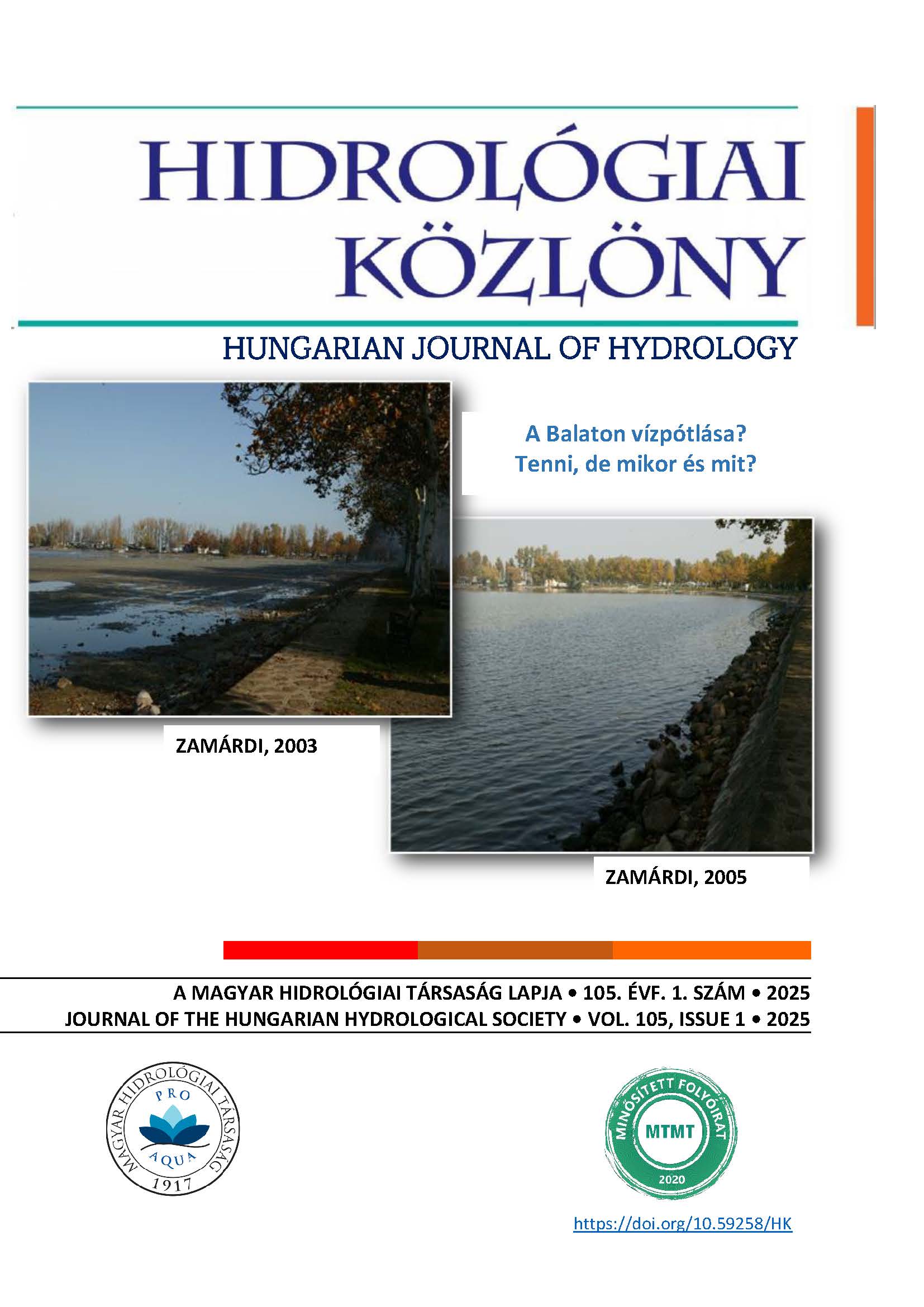Analysing the evaporation of Lake Fertő and comparing evaporation calculation methods in the context of climate change
Abstract
As a result of climate change, the factors influencing the water balance of Lake Fertő are also changing, leading to a decrease in the lake’s water resources. Many uncertainties burden the water balance and, thus, future forecasts. The most significant of them arises from the inaccurate determination of evapotranspiration as the primary loss component. Therefore, our research aimed to analyze the uncertainties associated with evaporation. The lake’s evaporation consists of two components: evaporation from the open water surface and transpiration from the reed zones, shaped not only by meteorological factors but also by the physiological processes of the vegetation. Thus, although we are faced with a complex process, in practice, it is still calculated using a very simple procedure, the empirical Meyer formula. In our research, we compared Meyer’s evaporation calculation method with an energy balance-based one over an 11-year-long period (2012-2022). We found that the Meyer method significantly overestimates evaporation, and its climatic forecasting ability is also uncertain, making its use questionable for Lake Fertő. The Meyer formula showed a significant closure error regarding the lake's water balance, averaging -243 mm/year. In contrast, the energy balance-based method resulted in a much smaller one of -56 mm/year. This means that we achieved a significantly better water balance closure when evaporation was determined based on physical principles. As a result, we concluded that for determining the evaporation of Lake Fertő, energy balance-based calculations should be used, as they are more accurate and grounded in physical principles, allowing for verification through measurements.
References
Anda, A., Silva, J., Soós, G., Teixeira da Silva, J. A. (2014). Evapotranspiration and crop coefficient of common reed at the surroundings of Lake Balaton, Hungary. Aquatic Botany, 116, pp. 53-59. https://doi.org/10.1016/j.aquabot.2014.01.008
Anda, A., Soós, G., Teixeira da Silva, J.A. (2017a). Leaf area index for common reed (Phragmites australis) with different water supplies in the Kis-Balaton wetland, Hungary, during two consecutive seasons (2014 and 2015). Időjárás, 121 (3), 265-284.
Anda, A., Soós, G., Teixeira da Silva, J. A. (2017b). Practical use of Phragmites australis to study evapotranspiration in a wetland zone of Lake Balaton (southwest Hungary). Theoretical and applied climatology, 127, 899-909. https://doi.org/10.1007/s00704-015-1679-4
Eitzinger, J., Kubu, G., Formayer, H., Haas, P., Gerersdorfer, T., Kromp-Kolb, H. (2009). Auswirkungen einer Klimaänderung auf den Wasserhaushalt des Neusiedlersees. In: Auswirkungen einer Klimaänderung auf den Wasserhaushalt des Neusiedlersees, Endbericht, Im Auftrag der Burgenländischen Landesregierung, 2005. BOKU-Met Report 1 (ISSN 1994-4179; ISSN 1994-4187 (on-line).
Fertő Konzorcium (2019). Vízminőség-védelmi célú vízgazdálkodási kezelési terv készítését megalapozó vizsgálatok a Fertő tavon. Kutatási jelentés, AT-HU 53 Interreg projekt, Budapest.
Foken, T. (2006). Micrometeorology. Springer-Verlag, Berlin Heidelberg.
Istvánovics, V., Honti, M., Torma, P., Kousal, J. (2022). Record‐setting algal bloom in polymictic Lake Balaton (Hungary): A synergistic impact of climate change and (mis)management. Freshwwater Biology, 67(6), 1091. 1106. https://doi.org/10.1111/fwb.13903
Jensen, M.E., Dotan, A., Sanford, R. (2005). Penman-Monteith Estimates of Reservoir Evaporation. Impacts of Global Climate Change, pp. 1-24. https://doi.org/10.1061/40792(173)548
KDTVIZIG (2023). A Velencei-tó 2022. évi vízmérlege. http://www.kdtvizig.hu
KDTVIZIG (2024). A Balaton és a tórészek havi vízháztartási jellemzőinek meghatározása. http://www.kdtvizig.hu
Kiss M., Józsa J. (2014). A Fertő tó energiaháztartásának meghatározása örvény-kovariancia módszerrel. Hidrológiai Közlöny, 94(4), pp. 38-47.
Kiss M., Torma P. (2014). Sekély tavi energiaáramok fluxus-gradiens eljárás-alapú becslése örvény-kovariancia mérésekből. Hidrológiai Közlöny, 94(4), pp. 48-56.
Kovács Á., Szilágyi J. (2009a). Párolgásszámítási vizsgálatok hazai nagy tavainkon, I. Hidrológiai Közlöny, 89(2), pp. 47-50.
Kovács Á., Szilágyi J. (2009b). Párolgásszámítási vizsgálatok hazai nagy tavainkon, II. Hidrológiai Közlöny, 89(2), pp. 51-56.
Lükő, G., Torma, P., Weidinger, T. (2022). Intra-Seasonal and Intra-Annual Variation of the Latent Heat Flux Transfer Coefficient for a Freshwater Lake. Atmosphere, 13(2), 352. https://doi.org/10.3390/atmos13020352
Metzger, J., Nied, M., Corsmeier, U., Kleffmann, J., Kottmeier, C. (2018). Dead Sea evaporation by eddy covariance measurements vs. aerodynamic, energy budget, Priestley–Taylor, and Penman estimates. Hydrology and Earth System Sciences, 22 (2), 135-155. https://doi.org/10.5194/hess-22-1135-2018
Meyer, A.F. (1942). Evaporation from lakes and reservoirs, a study based on fifty years’ Weather Bureau Records. Minnesota Resources Commission, St. Paul, Minnesota.
Nikolaou, G., Neocleous, D., Kitta, E., Katsoulas, N. (2023). Assessment of the Priestley-Taylor coefficient and a modified potential evapotranspiration model. Smart Agricultural Technology, 3, 100075 https://doi.org/10.1016/j.atech.2022.100075
Soja, G., Züger J., Knoflacher, M., Kinner, P., Soja, A. (2013). Climate impacts on water balance of a shallow steppe lake in Eastern Austria (Lake Neusiedl). Journal of Hydrology, 480. pp. 115-124. https://doi.org/10.1016/j.jhydrol.2012.12.013.
Török S.D., Torma P. (2024a). Fertő-tó nyílt vízének párolgása és nádasállományának párologtatása az éghajlatváltozás tükrében. Magyar Hidrológiai Társaság XLI. Országos Vándorgyűlés, Szolnok, 2024. július 3-5.
Török, S.D., Torma, P. (2024b). Prediction of long-term changes of weak diurnal stratification in shallow lakes using artificial neural networks. Journal of Water and Climate Change. jwc2024032. https://doi.org/10.2166/wcc.2024.032
Copyright (c) 2025 Sebestyén Dániel Török, Péter Torma

This work is licensed under a Creative Commons Attribution-NonCommercial-ShareAlike 4.0 International License.




